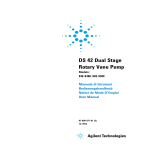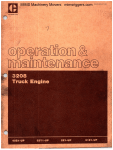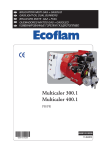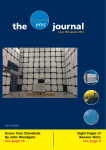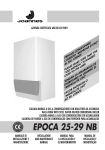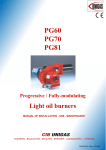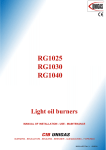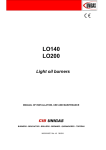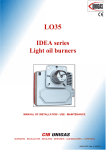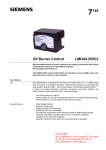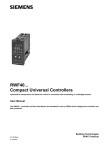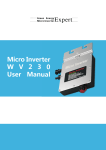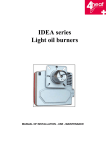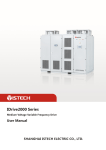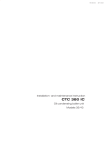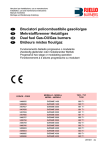Download PG91 PG92 PG93 - Arzatoare CIB Unigas
Transcript
PG91 PG92 PG93 Progressive, Fully-modulating Light oil burners MANUAL OF INSTALLATION - USE - MAINTENANCE BURNERS - BRUCIATORI - BRULERS - BRENNER - QUEMADORES - ГОРЕЛКИ M039186CB Rev. 1 05/2008 C.I.B. UNIGAS - M039186CB TABLE OF CONTENTS WARNINGS ................................................................................................................................................................ 3 PART I: INSTALLATION ........................................................................................................................................... 5 GENERAL FEATURES................................................................................................................................................................... 5 How to interpret the burner’s “Performance curve”.......................................................................................................................... 6 Technical specifications .................................................................................................................................................................. 7 Performance curves ........................................................................................................................................................................ 7 Overall dimensions ......................................................................................................................................................................... 8 MOUNTINGS AND CONNECTIONS .............................................................................................................................................. 9 Packing ........................................................................................................................................................................................... 9 Fitting the burner to the boiler ......................................................................................................................................................... 9 Handling the burner ...................................................................................................................................................................... 10 Hydraulic diagrams for light oil supplying circuits ......................................................................................................................... 10 Installation diagram of light oil pipes ............................................................................................................................................. 11 Light oil pumps .............................................................................................................................................................................. 12 Assembling the light oil flexible hoses .......................................................................................................................................... 13 About the use of fuel pumps ......................................................................................................................................................... 13 Light oil circuit ............................................................................................................................................................................... 14 Electrical connections ................................................................................................................................................................... 15 Motor rotation .............................................................................................................................................................................. 15 Light oil nozzles ............................................................................................................................................................................ 16 Adjustments - brief description...................................................................................................................................................... 18 Adjustment procedure ................................................................................................................................................................... 18 Oil Flow Rate Settings by means of Berger STM30.. actuator ..................................................................................................... 18 Adjustment by the Siemens SQL33.. actuator .............................................................................................................................. 21 Fully modulating burners ............................................................................................................................................................... 24 Calibration of air pressure switch (when provided) ....................................................................................................................... 24 PART II: OPERATION ............................................................................................................................................. 25 OPERATION ................................................................................................................................................................................. 25 Burner control panel ...................................................................................................................................................................... 26 PART III: MAINTENANCE ....................................................................................................................................... 27 ROUTINE MAINTENANCE ........................................................................................................................................................... 31 Light oil filter maintenance ............................................................................................................................................................ 27 Removing the combustion head ................................................................................................................................................... 28 Removing the oil gun .................................................................................................................................................................... 28 Correct position of electrodes and nozzle..................................................................................................................................... 29 Replacing the ignition electrodes .................................................................................................................................................. 29 Cleaning and replacing the detection photoresistor ...................................................................................................................... 29 Seasonal stop ............................................................................................................................................................................... 30 Burner disposal ............................................................................................................................................................................. 30 TROUBLESHOOTING .................................................................................................................................................................. 31 SPARE PARTS ........................................................................................................................................................................... 32 BURNER EXPLODED VIEW ........................................................................................................................................................ 34 ELECTRICAL WIRING DIAGRAMS ............................................................................................................................................. 35 APPENDIX 2 WARNINGS THIS MANUAL IS SUPPLIED AS AN INTEGRAL AND ESSENTIAL PART OF THE PRODUCT AND MUST BE DELIVERED TO THE USER. INFORMATION INCLUDED IN THIS SECTION ARE DEDICATED BOTH TO THE USER AND TO PERSONNEL FOLLOWING PRODUCT INSTALLATION AND MAINTENANCE. THE USER WILL FIND FURTHER INFORMATION ABOUT OPERATING AND USE RESTRICTIONS, IN THE SECOND SECTION OF THIS MANUAL. WE HIGHLY RECOMMEND TO READ IT. CAREFULLY KEEP THIS MANUAL FOR FUTURE REFERENCE.. 1) shall have qualified personnel carry out the following operations: a Remove the power supply by disconnecting the power cord from the mains. b) Disconnect the fuel supply by means of the hand-operated shut-off valve and remove the control handwheels from their spindles. GENERAL INTRODUCTION z The equipment must be installed in compliance with the regulations in force, following the manufacturer’s instructions, by qualified personnel. z Qualified personnel means those having technical knowledge in the field of components for civil or industrial heating systems, sanitary hot water generation and particularly service centres authorised by the manufacturer. z Improper installation may cause injury to people and animals, or damage to property, for which the manufacturer cannot be held liable. z Remove all packaging material and inspect the equipment for integrity. In case of any doubt, do not use the unit - contact the supplier. The packaging materials (wooden crate, nails, fastening devices, plastic bags, foamed polystyrene, etc), should not be left within the reach of children, as they may prove harmful. z Before any cleaning or servicing operation, disconnect the unit from the mains by turning the master switch OFF, and/or through the cutout devices that are provided. z Make sure that inlet or exhaust grilles are unobstructed. z In case of breakdown and/or defective unit operation, disconnect the unit. Make no attempt to repair the unit or take any direct action. Contact qualified personnel only. Units shall be repaired exclusively by a servicing centre, duly authorised by the manufacturer, with original spare parts. Failure to comply with the above instructions is likely to impair the unit’s safety. To ensure equipment efficiency and proper operation, it is essential that maintenance operations are performed by qualified personnel at regular intervals, following the manufacturer’s instructions. z When a decision is made to discontinue the use of the equipment, those parts likely to constitute sources of danger shall be made harmless. z In case the equipment is to be sold or transferred to another user, or in case the original user should move and leave the unit behind, make sure that these instructions accompany the equipment at all times so that they can be consulted by the new owner and/or the installer. z For all the units that have been modified or have options fitted then original accessory equipment only shall be used. z This unit shall be employed exclusively for the use for which it is meant. Any other use shall be considered as improper and, therefore, dangerous. The manufacturer shall not be held liable, by agreement or otherwise, for damages resulting from improper installation, use and failure to comply with the instructions supplied by the manufacturer. 2) Special warnings z Make sure that the burner has, on installation, been firmly secured to the appliance, so that the flame is generated inside the appliance firebox. z Before the burner is started and, thereafter, at least once a year, have qualified personnel perform the following operations: a set the burner fuel flow rate depending on the heat input of the appliance; b set the flow rate of the combustion-supporting air to obtain a combustion efficiency level at least equal to the lower level required by the regulations in force; c check the unit operation for proper combustion, to avoid any harmful or polluting unburnt gases in excess of the limits permitted by the regulations in force; d make sure that control and safety devices are operating properly; e make sure that exhaust ducts intended to discharge the products of combustion are operating properly; f on completion of setting and adjustment operations, make sure that all mechanical locking devices of controls have been duly tightened; g make sure that a copy of the burner use and maintenance instructions is available in the boiler room. z In case of repeated burner shut-downs, do not continue re-setting the unit manually. Contact qualified personnel to take care of such defects. z The unit shall be operated and serviced by qualified personnel only, in compliance with the regulations in force. 3) GENERAL INSTRUCTIONS DEPENDING ON FUEL USED 3a) z z z z z SPECIAL INSTRUCTIONS FOR BURNERS z The burner should be installed in a suitable room, with ventilation openings complying with the requirements of the regulations in force, and sufficient for good combustion. z Only burners designed according to the regulations in force should be used. z This burner should be employed exclusively for the use for which it was designed. z Before connecting the burner, make sure that the unit rating is the same as delivery mains (electricity, gas oil, or other fuel). z Observe caution with hot burner components. These are, usually, near to the flame and the fuel pre-heating system, they become hot during the unit operation and will remain hot for some time after the burner has stopped. When the decision is made to discontinue the use of the burner, the user z ELECTRICAL CONNECTION For safety reasons the unit must be efficiently earthed and installed as required by current safety regulations. It is vital that all saftey requirements are met. In case of any doubt, ask for an accurate inspection of electrics by qualified personnel, since the manufacturer cannot be held liable for damages that may be caused by failure to correctly earth the equipment. Qualified personnel must inspect the system to make sure that it is adequate to take the maximum power used by the equipment shown on the equipment rating plate. In particular, make sure that the system cable cross section is adequate for the power absorbed by the unit. No adaptors, multiple outlet sockets and/or extension cables are permitted to connect the unit to the electric mains. An omnipolar switch shall be provided for connection to mains, as required by the current safety regulations. The use of any power-operated component implies observance of a few basic rules, for example: © do not touch the unit with wet or damp parts of the body and/or with bare feet; © do not pull electric cables; © do not leave the equipment exposed to weather (rain, sun, etc.) unless expressly required to do so; © do not allow children or inexperienced persons to use equipment; z The unit input cable shall not be replaced by the user. In case of damage to the cable, switch off the unit and contact qualified personnel to replace. When the unit is out of use for some time the electric switch supplying all 3 DIRECTIVES AND STANDARDS Gas burners European directives: - Directive 90/396/CEE - Gas Appliances; - Directive 2006/95/EC on low voltage; - Directive 2004/108/CEE on electromagnetic compatibility Harmonised standards : -UNI EN 676 (Gas Burners; -CEI EN 60335-1(Household and similar electrical appliances - Safety. Part 1: General requirements; - EN 50165 (Electrical equipment of non-electric appliances for household and similar purposes. Safety requirements. the power-driven components in the system (i.e. pumps, burner, etc.) should be switched off. 3b) FIRING WITH GAS, LIGHT OIL OR OTHER FUELS GENERAL z The burner shall be installed by qualified personnel and in compliance with regulations and provisions in force; wrong installation can cause injuries to people and animals, or damage to property, for which the manufacturer cannot be held liable. z Before installation, it is recommended that all the fuel supply system pipes be carefully cleaned inside, to remove foreign matter that might impair the burner operation. z Before the burner is commissioned, qualified personnel should inspect the following: a the fuel supply system, for proper sealing; b the fuel flow rate, to make sure that it has been set based on the firing rate required of the burner; c the burner firing system, to make sure that it is supplied for the designed fuel type; d the fuel supply pressure, to make sure that it is included in the range shown on the rating plate; e the fuel supply system, to make sure that the system dimensions are adequate to the burner firing rate, and that the system is equipped with all the safety and control devices required by the regulations in force. z When the burner is to remain idle for some time, the fuel supply tap or taps should be closed. Light oil burners European directives: - Directive 2006/95/EC on low voltage; - Directive 2004/108/CEE on electromagnetic compatibility Harmonised standards : -CEI EN 60335-1(Household and similar electrical appliances - Safety. Part 1: General requirements; - EN 50165 (Electrical equipment of non-electric appliances for household and similar purposes. Safety requirements. National standards : -UNI 7824: Monobloc nebulizer burners for liquid fuels. Characteristics and test methods Heavy oil burners European directives: - Directive 2006/95/EC on low voltage; - Directive 2004/108/CEE on electromagnetic compatibility Harmonised standards : -CEI EN 60335-1 Household and similar electrical appliances - SafetyPart 1: General requirements; - EN 50165 Electrical equipment of non-electric appliances for household and similar purposes. Safety requirements. National standards : -UNI 7824: Monobloc nebulizer burners for liquid fuels. Characteristics and test methods SPECIAL INSTRUCTIONS FOR USING GAS Have qualified personnel inspect the installation to ensure that: a the gas delivery line and train are in compliance with the regulations and provisions in force; b all gas connections are tight; c the boiler room ventilation openings are such that they ensure the air supply flow required by the current regulations, and in any case are sufficient for proper combustion. z Do not use gas pipes to earth electrical equipment. z Never leave the burner connected when not in use. Always shut the gas valve off. z In case of prolonged absence of the user, the main gas delivery valve to the burner should be shut off. Precautions if you can smell gas a do not operate electric switches, the telephone, or any other item likely to generate sparks; b immediately open doors and windows to create an air flow to purge the room; c close the gas valves; d contact qualified personnel. z Do not obstruct the ventilation openings of the room where gas appliances are installed, to avoid dangerous conditions such as the development of toxic or explosive mixtures. Gas - Light oil burners European directives: - Directive 90/396/CEE Gas Appliances; - Directive 2006/95/EC on low voltage; - Directive 2004/108/CEE on electromagnetic compatibility Harmonised standards : -UNI EN 676 Gas Burners -CEI EN 60335-1(Household and similar electrical appliances - Safety. Part 1: General requirements; - EN 50165 Electrical equipment of non-electric appliances for household and similar purposes. Safety requirements. National standards : -UNI 7824: Monobloc nebulizer burners for liquid fuels. Characteristics and test methods Gas - Heavy oil burners European directives: - Directive 90/396/CEE - Gas Appliances; - Directive 2006/95/EC on low voltage; - Directive 2004/108/CEE on electromagnetic compatibility Harmonised standards : -UNI EN 676 (Gas Burners; -CEI EN 60335-1(Household and similar electrical appliances - Safety. Part 1: General requirements; - EN 50165 Electrical equipment of non-electric appliances for household and similar purposes. Safety requirements. National standards : -UNI 7824: Monobloc nebulizer burners for liquid fuels. Characteristics and test methods 4 C.I.B. UNIGAS - M039186CB PART I: INSTALLATION GENERAL FEATURES The burners of this series represent monoblock burners made in die-cast aluminium housing with relative flange to work on heating generators. The output range is from 700kW to 4000kW (according to the model). They can be provided in progressive or fully-modulating version. 5 4 6 3 7 8 9 10 11 12 2 1 Fig. 1 1 2 3 4 5 6 7 8 9 10 11 12 Gun and head adjusting ring nut Control panel Electrical panel Burner cover Burner flange Blast tube-combustion head ass.y Photoresistance Pressure governor Air intake Adjusting cam Pump Actuator The fuel coming from the supply line, is pushed by the pump (11) to the nozzle and then into the combustion chamber, where the mixture between fuel and air takes place and consequently the flame. In the burners, the mixture bertween fuel and air, to perform clean and efficient combustion, is activated by atomisation of oil into very small particles. This process is achieved making pressurised oil pass through the nozzle. The pump (11) main function is to transfer oil from the tank to the nozzle at required quantity and pressure. To adjust pressure, pumps are provided with a pressure governor. The electric actuator (12) moves the air damper and allows the optimisation of the gas flue values, as to get an efficient combustion. The position of the combustion head determines the burner output. The air (comburent) and fuel (light oil) are forced into the combustion chamber, as to let the flame light up. 5 C.I.B. UNIGAS - M039186CB How to interpret the burner’s “Performance curve” To check if the burner is suitable for the boiler to which it must be installled, the following parameters are needed: z furnace input, in kW or kcal/h (kW = kcal/h / 860); z backpressure (data are available on the boiler ID plate or in the user’s manual). Example: Furnace input: 600kW Backpressure: 4mbar In the “Performance curve” diagram (Fig. 2), draw a vertical line matching the furnace input value and an horizontal line matching the backpressure value. The burner is suitable if the intersection point A is inside the performance curve. Campo di lavoro bruciatori Tipo P60 Mod. M-xx.x.IT.A.0.50 - M-.xx.x.IT.A.0.65 Contropressione in camera di combustione mbar 8 7 6 5 A 4 3 2 1 0 -1 100 200 300 400 500 600 700 800 900 Potenza kW Fig. 2 Data are referred to standard conditions: atmospheric pressure at 1013mbar, ambient temperature at 15°C. Burner model identification Burners are identified by burner type and model. Burner model identification is described as follows. Type PG92 Model G-. PR. S. *. A. (1) (2) (3) (4) (5) (6) (1) BURNER TYPE PG91-PG92-PG93 (2) FUEL G - Light oil A - Biodiesel (3) OPERATION (Available versions) (4) BLAST TUBE PR - Progressive MD - Fully modulating L - Extended (5) DESTINATION COUNTRY S - Standard * - see data plate (6) BURNER VERSION A - Standard 6 C.I.B. UNIGAS - M039186CB Technical specifications BURNERS PG91 PG92 PG93 min. -max. kW 698 - 2093 849 - 2558 550 - 4100 min. -max. kg/h 59 - 176 72 - 215 46 - 345 Output Light oil rate Fuel Light oil Viscosity Density cSt @ 40 °C 2 - 7.4 kg/m3 0.84 Power supply 400V 3N ~ 50Hz Electric motor kW 4 5.5 7.5 Total power consumption kW 4.5 6 IP40 8 kg 220 220 Progressive - Fully modulating 230 Index of protection Approx. weight Operation Operating temperature °C -10 ÷ +50 Storage temperature °C -20 ÷ +60 Working service * Intermittent NOTE: Choosing the nozzle for light oil, consider Hi equal to 10200 kcal/kg. * NOTE ON THE WORKING SERVICE: the Siemens LMO.. control box automatically stops after 24h of continuous working. The control box immediately starts up, automatically. BACK PRESSURE IN BACK PRESSURE IN CCOMBUSTION CHAMBER mbar COMBUSTION CHAMBER mbar Performance curves PG91 PG92 18 16 14 12 10 8 6 4 2 0 18 16 14 12 10 8 6 4 2 0 400 800 1200 1600 2000 400 2400 800 1200 1600 2000 PG93 16 14 12 10 8 6 4 2 0 0 2400 2800 kW kW 500 1000 1500 2000 2500 3000 3500 4000 4500 kW To get the input in kcal/h, multiply value in kW by 860. Data are referred to standard conditions: atmosferic pressure at 1013mbar, ambient temperature at 15°C 7 Overall dimensions (mm) boiler drilling plate 8 C.I.B. UNIGAS - M039186CB burner flange AS PG91 PG92 PG93 AL AA BS* BL* BB C CC D E F G H K L M N 1259 1432 242 300 473 419 918 422 935 422 513 238 268 360 464 M12 417 280 1253 1426 242 294 467 419 918 422 935 422 513 266 296 360 464 M12 417 280 1253 1426 243 294 467 460 918 422 935 422 513 266 296 360 464 M12 417 280 *BS: standard blast tube *BL: extended blast tube Omin Omax P W Y Z 310 295 649 196 185 310 295 649 213 185 310 295 649 213 185 C.I.B. UNIGAS - M039186CB MOUNTINGS AND CONNECTIONS Packing The burners are dispatched in wooden pakages whose dimensions are:1730mm x 1280mm x 1020mm (L x P x H) Packing cases of this kind are affected by humidity and are not suitable for stacking. The following are placed in each packing case. 1 burner; H 2 light oil flexible hoses; 1 light oil filter; P 1 gasket to be inserted between the burner and the boiler; 1 envelope containing this manual. To get rid of the burner packing, follow the procedures laid down by current laws on disposal of materials. L Fitting the burner to the boiler To install the burner into the boiler, proceed as follows: 1 make a hole on the closing door of the combustion chamber as described on paragraph “Overall dimensions”) 2 place the burner to the boiler: lift it up and handle it according to the procedure described on paragraph “Handling the burner”; 3 place the 4 stud bolts (5) on the hole of the boiler’s door, according to the burner’s drilling plate described on paragraph “Overall dimensions”; 4 fasten the 4 stud bolts; 5 place the gasket on the burner flange; 6 install the burner into the boiler; 7 fix the burner to the stud bolts, by means of the fixing nuts, according to the next picture. 8 After fitting the burner to the boiler, ensure that the gap between the blast tube and the refractory lining is sealed with appropriate insulating material (ceramic fibre cord or refractory cement). Keys 1 2 3 4 5 7 Burner Fixing nut Washer Sealing gasket Stud bolt Blast tube Handling the burner ATTENTION! The lhandling operations must be carried out by specialised and trained personnel. If these operations are not carried out correctly, the residual risk for the burner to overturn and fall down still persists. To move the burner, use means suitable to support its weight (see paragraph “Technical specifications”). The unpacked burner must be lifted and moved only by means of a fork lift truck. The burner is mounted on a stirrup provided for handling the burner by means of a fork lift truck: the forks must be inserted into the A anb B ways. Remove the stirrup only once the burner is installed to the boiler. A 9 B C.I.B. UNIGAS - M039186CB Hydraulic diagrams for light oil supplying circuits Fig. 3 - Gravity circuit Fig. 4 - Ring circuit Fig. 5 - Suction circuit Key 1 Manual valve 2 Light oil filter 3 Light oil feeding pump 4 One way valve 5 Flexible hoses 6 Relief valve NOTE: in plants where gravity or ring feed systems are provided, install an automatic interception device (see n. 4). 10 C.I.B. UNIGAS - M039186CB Installation diagram of light oil pipes PLEASE READ CAREFULLY THE “WARNINGS” CHAPTER AT THE BEGINNING OF THIS MANUAL. From tank To tank Fig. 6 - Double-pipe system The burner is supplied with filter and flexible hoses, all the parts upstream the filter must be installed by the customer. As far as the hoses connection, see the related paragraph.. (*) Only for installations with gravity, siphon or forced circulation feed systems. If the device installed is a solenoid valve, a timer must be installed to delay the valve closing. The direct connection of the device without a timer may cause pump breaks. Key 1 Burner 2 Flexible hoses (fitted) 3 Light oil filter (fitted) 4 Automatic interceptor (*) 5 One-way valve (*) 6 Gate valve 7 Quick-closing gate-valve (outside the tank or boiler rooms) The pumps that are used can be installed both into single-pipe and double-pipe systems. Single-pipe system: a single pipe drives the oil from the tank to the pump’s inlet. Then, from the pump, the pressurised oil is driven to the nozzle: a part comes out from the nozzle while the othe part goes back to the pump. In this system, the by-pass plug, if provided, must be removed and the optional return port, on the pump’s body, must be sealed by steel plug and washer. Double-pipe system: as for the single pipe system, a pipe that connects the tank to the pump’s inlet is used besides another pipe that connects the pump’s return port to the tank, as well. The excess of oil goes back to the tank: this installation can be considered self-bleeding. If provided, the inside by-pass plug must be installed to avoid air and fuel passing through the pump. Burners come out from the factory provided for double-pipe systems. They can be suited for single-pipe system (recommended in the case of gravity feed) as decribed before. To change from a 1-pipe system to a 2-pipe-system, insert the by-pass plug G (as for ccw-rotation- referring to the pump shaft). Caution: Changing the direction of rotation, all connections on top and side are reversed. Suntec TA G Bleed Bleeding in two-pipe operation is automatic : it is assured by a bleed flat on the piston. In one-pipe operation, the plug of a pressure gauge port must be loosened until the air is evacuated from the system. 11 C.I.B. UNIGAS - M039186CB Light oil pumps Suntec TA.. Oil viscosity Oil temperature 4 - 450 cSt 0 - 140°C Min. suction pressure Max. suction pressure Max. return pressure Rotation speed - 0.45 barto avoid gasing 5 bar 5 bar 3600 rpm max. Key 1 2 3 5 7 8 Pressure regulator Pressure/Vacuum gauge port to measure inlet pressure/vacuum Pressure gauge port Suction To the nozzle Return Assembling the light oil flexible hoses To connect the flexible light oil hoses to the pump, proceed as follows, according to the pump provided: 1 remove the closing nuts A and R on the inlet and return connections of the pump; 2 screw the rotating nut of the two flexible hoses on the pump being careful to avoid exchanging the inlet and return lines: see the arrows marked on the pump that show the inlet and the return (see prevoius paragraph). Suntec TA A R 12 C.I.B. UNIGAS - M039186CB About the use of fuel pumps z z z z z z z z Make sure that the by-pass plug is not used in a single pipe installation, because the fuel unit will not function properly and damage to the pump and burner motor could result. Do not use fuel with additives to avoid the possible formation over time of compounds which may deposit between the gear teeth, thus obstructing them. After filling the tank, wait before starting the burner. This will give any suspended impurities time to deposit on the bottom of the tank, thus avoiding the possibility that they might be sucked into the pump. On initial commissioning a "dry" operation is foreseen for a considerable length of time (for example, when there is a long suction line to bleed). To avoid damages inject some lubrication oil into the vacuum inlet. Care must be taken when installing the pump not to force the pump shaft along its axis or laterally to avoid excessive wear on the joint, noise and overloading the gears. Pipes should not contain air pockets. Rapid attachment joint should therefore be avoided and threaded or mechanical seal junctions preferred. Junction threads, elbow joints and couplings should be sealed with removable sg component. The number of junctions should be kept to a minimum as they are a possible source of leakage. Do not use PTFE tape on the suction and return line pipes to avoid the possibility that particles enter circulation. These could deposit on the pump filter or the nozzle, reducing efficiency. Always use O-Rings or mechanical seal (copper or aluminium gaskets) junctions if possible. An external filter should always be installed in the suction line upstream of the fuel unit. 13 C.I.B. UNIGAS - M039186CB Light oil circuit The fuel is pushed into the pump 1 to the nozzle 3 at the delivery pressure set by the pressure governor. The solenoid valve 2 set the fuel immission into the combustion chamber. The part of fuel that is not burnt goes back to the tank through the return circuit. The fuel amount to be burnt is adjusted by means of the burner actuator according to the adjustments set (see pag. 22). Fig. 7 - Stand-by Fig. 8 - Prepurge Fig. 9 - Low flame Fig. 10 - High flame Key 1 Light oil pump 2 Light oil solenoid valve 3 Nozzle 4 Actuator 5 Adjusting cam 6 pressure gauge 7 Pressure regulator 8 One-way valve 14 C.I.B. UNIGAS - M039186CB Electrical connections RESPECT THE BASIC SAFETY RULES. MAKE SURE OF THE CONNECTION TO THE EARTHING SYSTEM. DO NOT REVERSE THE PHASE AND NEUTRAL CONNECTIONS. FIT A DIFFERENTIAL THERMAL MAGNET SWITCH ADEQUATE FOR CONNECTION TO THE MAINS. STRICTLY OBSERVE THE DATA PLATE. z z Remove the cover from the burner electrical panel. Execute the electrical connections to the power supply terminal board as shown here following, check the direction of the motor (see next paragraph) and replace the cover of the electrical panel. WARNING: The burner is provided with a jumper between terminals 6 and 7; in the event of connecting the high/ low flame thermostat remove this jumper before connecting the thermostat. IMPORTANT: while connecting electric supply wires to burner’s teminal block be sure that ground wire should be longer than phase and neutral ones. Progressive burners Probes connection Fig. 11 Fully-modulating burners Fig. 13 Probes connection oby means of the 7-pins plug (Fig. 14) see Fig. 12 for connections. Fig. 12 Fig. 14 Motor rotation Once the burner electrical connection is accomplished, remember to check the rotation of the fan motor. The motors must rotate in the direction showed on their casing. In the event of wrong rotation, reverse the three-phase supply and check again the motor rotation. NOTE: Burners are provided for three-phase 400 V supply, and in the case of three-phase 230 V supply it is necessary to modify the electrical connections inside the terminal box of the electric motor and replace the thermal cutout relay. 15 C.I.B. UNIGAS - M039186CB ADJUSTING LIGHT OIL FOLW RATE Light oil nozzles The light oil flow rate can be adjusted choosing a by-pass nozzle that suits the boiler/utilisation’s output and setting the delivery and return pressure values according to the values quoted on diagrams on Fig. 15 and Fig. 16, according to the burner type. Nozzles provided are the following according to the burner type. As far as reading the pressure values, see next paragraphs. PG91 - PG92: Bergonzo A3 (Fig. 16) PG93: Fluidics WR2 (Fig. 15) NOZZLE DELIVERY PRESSURE bar RETURN PRESSURE MAX. bar RETURN PRESSURE MIN. bar BERGONZO A3 20 11 ÷ 13 5 (recommended)) FLUIDICS WR2 25 20 7 (recommended) Example (Fulidics): as far as over 100kg/h nozzle the 80% of the nozzle rated flow rate is achieved with 18bar return pressure (see picture above). Pressure at nozzle 357psi FLOW RATE kg/h DIMENSIONS Min Max 40 13 40 50 16 50 60 20 60 70 23 70 80 26 80 90 30 90 100 33 100 115 38 115 130 43 130 145 48 145 160 53 160 180 59 180 200 66 200 225 74 225 250 82 250 275 91 275 300 99 300 330 109 330 360 119 360 400 132 400 450 148 450 500 165 500 550 181 550 600 198 600 650 214 650 700 231 700 750 250 750 800 267 800 Pressure on return Pressure on return Up to 100kg/h Over 100kg/h % Flow rate Fig. 15 Example (Bergonzo): if a 220kg/h flow rate BERGONZO nozzle is provided, set the return pressure at 11bar, supply at 20bar on the delivery to get a 220kg/h flow rate. If the return pressure needed is 5bar, instead, act on the V adjusting screw on the pressure regulator (see chapter “ADJUSTMENTS”). The flow rate will then be about 95kg/h (see the example shown on the Bergonzo diagram on next page). 16 C.I.B. UNIGAS - M039186CB Fig. 16 17 C.I.B. UNIGAS - M039186CB Adjustments - brief description ATTENTION: before starting the burner up, be sure that the manual cutoff valves are open. Be sure that the mains switch is closed. . Before starting up the burner, make sure that the return pipe to the tank is not obstructed. Any obstruction would cause the pump seal to break. .ATTENTION: During commissioning operations, do not let the burner operate with insufficient air flow (danger of formation of carbon monoxide); if this should happen, make the fuel decrease slowly until the normal combustion values are achieved. IMPORTANT! the combustion air excess must be adjusted according to the in the following chart: Recommended combustion parameters Fuel Recommended (%) CO2 Recommended (%) O2 Light oil 11.5 ÷ 13 2.9 ÷ 4.9 Adjust the air and fuel flow rates at the maximum output (“high flame”) first, by means of the air damper and the adjusting cam respectively. z Check that the combustion parameters are in the suggested limits. z z z Check the flow rate . . Then, adjust the combustion values corresponding to the points between maximum and minimum: set the shape of the adjusting cam foil. The adjusting cam sets the air/fuel ratio in those points, regulating the opening-closing of the fuel governor. Set, now, the low flame output, acting on the low flame microswitch of the actuator in order to avoid the low flame output increasing too much or that the flues temperature gets too low to cause condensation in the chimney. Adjustment procedure To change the burner setting during the testing in the plant, follow the next procedure, according to the actuator model provided (mod. Berger STM30.. or mod. Siemens SQL..). Oil Flow Rate Settings by means of Berger STM30.. actuator 1 Open the electrical panel to check the fan-pump motor rotation and act directly on its contactor CV (see next picture): keep pressed for some seconds until the oil circuit is charged; CV 2 bleed the air from the M pressure gauge port (Fig. 17) by loosing the cap without removing it, then release the contactor. Suntec TA.. M VR Fig. 17 3 4 Before starting the burner up, drive the high flame actuator microswitch matching the low flame one (in order to let the burner operates at the lowest output) to achieve safely the high flame stage . Turn the burner on by means of its main switch A: if the burner locks (LED B on in the control panel) press the RESET button (C) on the control panel (see next picture) - see chapter “OPERATION” on page 26. 18 C.I.B. UNIGAS - M039186CB B C 5 6 7 8 A be sure that the actuator cam for the “Startup enabling signal” (when used) is about 5° more than the ignition cam; start the burner up by means of the thermostat series and wait until the pre-purge time comes to an end; drive the burner to high flame stage, by means fo the thermostat TAB. Then move progressively the microswitch to higher values until it reaches the high flame position; always check the combustion values and eventually adjusting the oil pressure (see next step). MAN-AUTO STM30.. Actuator cams I II III V 9 High flame Stand-by and Ignition Low flame Start enabling signal the nozzle suplly pressureis already factory-set and must not be changed. Only if necessary, adjust the supply pressure as follows (see related paragraph);insert a pressure gauge into the port showed on Fig. 18 and act on on the pump adjusting screw VR (see Fig. 17) as to get the nozzle pressure at 20bar or 25bar (according to the nozzle model: Bergonzo or Fluidics nozzle - see page 18). PG RP V SV Pressure gauge port Fig. 18 Fig. 19 10 in order to get the maximum oil flow rate, adjust the pressure (reading its value on the PG pressure gauge) without changing the air flow rate set during the gas operation adjustments (see prevoius paragraph): checking always the combustion parameters, the adjustment is to be performed by means of the SV adjusting cam screw (see picture) when the cam has reached the high flame position. 11 To adjust the air flow rate in the high flame stage, loose the RA nut and screw VRA as to get the desired air flow rate: moving the rod TR towards the air damper shaft, the air damper opens and consequently the air flow rate increases, moving it far from the shaft the air damper closes and the air flow rate decreases. Note: once the procedure is perfomed, be sure that the blocking nut RA is fasten. Do not change the position of the air damper rods. 19 C.I.B. UNIGAS - M039186CB TR RA VRA 12 Only if necessary, change the combusiton head position: to let the burner operate at a lower output, loose the VB screw and move progressively back the combustion head towards the MIN position, by turning clockwise the VRT ring nut. Fasten VB screw when the adjustment is accomplished. VRT VB ”MIN” position ”MAX” position) Attention! if it is necessary to change the head position, repeat the air and gas adjustments described above. 13 the air and oil rate are now adjusted at the maximum power stage, go on with the point to point adjustement on the SV adjusting cam as to reach the minimum output point. RP ID V SC SV 14 as for the point-to-point regulation in order to set the cam foil shape, move the low flame microswitch (cam III) a little lower than the maximum position (90°); 15 set the TAB thermostat to the minimum in order that the actuator moves progressively towards the low flame position; 16 move cam III (low flame) towards the minimum to move the actuator towards the low flame until the two bearings find the adjusting screw that refers to a lower position: screw V to increase the rate, unscrew to decrease, in order to get the pressure as showed on diagram in Fig. 28, according to the requested rate. 17 Move again cam III towards the minimum to meet the next screw on the adjusting cam and repeat the previous step; go on this way as to reach the desired low flame point. 18 The low flame position must never match the ignition position that is why cam III must be set 20°- 30° more than the ignition position. Turn the burner off; then start it up again. If the adjustment is not correct, repeat the previous steps. 20 C.I.B. UNIGAS - M039186CB Adjustment by the Siemens SQL33.. actuator 1 Open the electrical panel to check the fan-pump motor rotation and act directly on the its contactor CV (see next picture): keep pressed for some seconds until the oil circuit is charged; CV 2 bleed the air from the M pressure gauge port (Fig. 20) by loosing the cap without removing it, then release the contactor. Suntec TA.. M VR Fig. 20 3 Turn the burner on by means of its main switch A: if the burner locks (LED B on in the control panel) press the RESET button (C) on the control panel (see next picture) - see chapter “OPERATION” on page 26. B C 4 A be sure that the actuator cam for the “Startup enabling signal” (when used) is about 5° more than the ignition cam; SQL330.. actuator cams AB = High flame cam BF = Low flame cam B = plastic cam G = cam locking lever CP= Start signal cam AUT MAN AB B G 21 C.I.B. UNIGAS - M039186CB AB BF CP 5 6 Start the burner up by means of the thermostat series and wait unitl the pre-purge phase comes to end; the burner starts up with the actuator on the ignition position, set it to the MAN (manual mode), by the MAN/AUTO selector (ignition position= read on the air damper index ID1 - see picture on pag.23); 7 disconnect the TAB thermostat removing the wire from the terminal no. 6 or by setting MAN on the RWF40 modulatore or by setting 0 by means of the CMF switch (only for fully-modulating burners); 8 set the actuator on the manual mode (MAN) by means of the MAN/AUTO switch (see next pictures). 9 manually drive the adjusting cam SV to the high flame position and set the actuator to the AUTO mode (by the related switch - see picture) to lock the adjusting cam. 10 the nozzle suplly pressureis already factory-set and must not be changed. Only if necessary, adjust the supply pressure as follows (see related paragraph);insert a pressure gauge into the port showed on Fig. 21 and act on on the pump adjusting screw VR (see Fig. 20) as to get the nozzle pressure at 20bar or 25bar (according to the nozzle model: Bergonzo or Fluidics nozzles - see page 18). PG RP V SV Pressure gauge port Fig. 21 Fig. 22 11 in order to get the maximum oil flow rate, adjust the pressure (reading its value on the PG pressure gauge) without changing the air flow rate set during the gas operation adjustments (see prevoius paragraph): checking always the combustion parameters, the adjustment is to be performed by means of the SV adjusting cam screw (see picture) when the cam has reached the high flame position. 12 To adjust the air flow rate in the high flame stage, loose the RA nut and screw VRA as to get the desired air flow rate: moving the rod TR towards the air damper shaft, the air damper opens and consequently the air flow rate increases, moving it far from the shaft the air damper closes and the air flow rate decreases. Note: once the procedure is perfomed, be sure that the blocking nut RA is fasten. Do not change the position of the air damper rods. TR RA VRA 13 Only if necessary, change the combusiton head position: to let the burner operate at a lower output, loose the VB screw and move 22 C.I.B. UNIGAS - M039186CB progressively back the combustion head towards the MIN position, by turning clockwise the VRT ring nut. Fasten VB screw when the adjustment is accomplished. VRT VB ”MIN” position ”MAX” position) Attention! if it is necessary to change the head position, repeat the air and oil adjustments described above. 14 once the air and oil flow rate have been adjusted at the maximum output, go on with the point to point adjustment on the SV adjusting cam as to reach the minimum output point: gradually move the adjusting cam in order to adjust each of the V screws as to describe the cam foil shape. RP V ID SV SC 15 to change the SV position set the actuator on the manual mode (MAN), turn the adjusting cam SV and set again the actuator to the AUTO mode to lock the adjusting cam; 16 act on the V screw that mathces the bearings referring to the adjusting cam position; 17 to adjust the next screw, set again the actuator mode to MAN, turn the adjusting cam and set the actuator to AUTO mode to lock the adjusting cam on the next screw; adjust it and go on this way to adjust all the screws in order to set the cam foil shape, according to the combustion values read. 18 Once the cam foil shape is defined, reconnect the TAB thermostat reconnecting the wire to the terminal no.6 or setting the RWF40 burner modulator to AUTO or the CMF switch to 3 (only for fully-modulating burner). 19 Turn the burner off then start it up again. 20 Once the pre-purge time comes to end, drive the burner to the high flame stage by the TAB thermostat: check the combustion values; 21 drive the burner to low flame, if necessary adjust the low flame size (output) by inserting a screwdriver on the slot F to move the BF cam. BF F 22 The low flame position must never match the ignition position that is why cam BF must be set 20°- 30° more than the ignition position. NOTE: to change the low flame position, act exclusively on the actuator cam. 23 Now adjust the pressure switch (if provided -see page 24). 23 C.I.B. UNIGAS - M039186CB Fully modulating burners To adjust the fully-modulating burners, use the CMF switch on the burner control panel (see next picture), instead of the TAB thermostat as described on the previous paragraphs about the progressive burners. Go on adjusting the burner as described before, paying attention to use the CMF switch intead of TAB. The CMF position sets the oprating stages: to drive the burner to the high-flame stage, set CMF=1; to drive it to the low-flame stage, set CMF=2. To move the adjusting cam set CMF=1 or CMF=2 and then CMF=0. CMF = 0 CMF = 1 CMF = 2 CMF = 3 stop high flame operation high flame operation flame operation automatic operation CMF Calibration of air pressure switch (when provided) To calibrate the air pressure switch, proceed as follows: z Remove the transparent plastic cap. z Once air and gas setting have been accomplished, startup the burner. z During the pre-purge phase o the operation, turn slowly the adjusting ring nut VR in the clockwise direction until the burner lockout, then read the value on the pressure switch scale and set it to a value reduced by 15%. z Repeat the ignition cycle of the burner and check it runs properly. z Refit the transparent plastic cover on the pressure switch. 24 C.I.B. UNIGAS - M039186CB PART II: OPERATION LIMITATIONS OF USE THE BURNER IS AN APPLIANCE DESIGNED AND CONSTRUCTED TO OPERATE ONLY AFTER BEING CORRECTLY CONNECTED TO A HEAT GENERATOR (E.G. BOILER, HOT AIR GENERATOR, FURNACE, ETC.), ANY OTHER USE IS TO BE CONSIDERED IMPROPER AND THEREFORE DANGEROUS. THE USER MUST GUARANTEE THE CORRECT FITTING OF THE APPLIANCE, ENTRUSTING THE INSTALLATION OF IT TO QUALIFIED PERSONNEL AND HAVING THE FIRST COMMISSIONING OF IT CARRIED OUT BY A SERVICE CENTRE AUTHORISED BY THE COMPANY MANUFACTURING THE BURNER. A FUNDAMENTAL FACTOR IN THIS RESPECT IS THE ELECTRICAL CONNECTION TO THE GENERATOR’S CONTROL AND SAFETY UNITS (CONTROL THERMOSTAT, SAFETY, ETC.) WHICH GUARANTEES CORRECT AND SAFE FUNCTIONING OF THE BURNER. THEREFORE, ANY OPERATION OF THE APPLIANCE MUST BE PREVENTED WHICH DEPARTS FROM THE INSTALLATION OPERATIONS OR WHICH HAPPENS AFTER TOTAL OR PARTIAL TAMPERING WITH THESE (E.G. DISCONNECTION, EVEN PARTIAL, OF THE ELECTRICAL LEADS, OPENING THE GENERATOR DOOR, DISMANTLING OF PART OF THE BURNER). NEVER OPEN OR DISMANTLE ANY COMPONENT OF THE MACHINE. OPERATE ONLY THE MAIN SWITCH, WHICH THROUGH ITS EASY ACCESSIBILITY AND RAPIDITY OF OPERATION ALSO FUNCTIONS AS AN EMERGENCY SWITCH, AND ON THE RESET BUTTON. IN THE EVENT OF REPEATED LOCKOUTS, DO NOT PERSIST WITH THE RESET BUTTON AND CONTACT QUALIFIED PERSONNEL WHO WILL PROCEED TO ELIMINATE THE MALFUNCTION. WARNING: DURING NORMAL OPERATION THE PARTS OF THE BURNER NEAREST TO THE GENERATOR (COUPLING FLANGE) CAN BECOME VERY HOT, AVOID TOUCHING THEM SO AS NOT TO GET BURNT. 25 C.I.B. UNIGAS - M039186CB OPERATION ATTENTION: before starting the burner up, be sure that the manual cutoff valves are open . Be usre that the mains switch is closed. 1 2 3 4 5 6 7 8 Set to the ON position the switch A on the control panel of the burner. Check the control box is not in the lockout position (light B must be off); in such a case reset it by the reset pushbutton C. Check the series of thermostats (or pressure switches) sends the burner the signal to operate. The startup sequence begins: the control box ignites the fan/pump motor and energises the ignition transformer as well (signalled by the light H on the burner control panel). At the end of the pre-purge stage, the light oil solenoid valve EVG is energised (signalled by the lamp G on the control panel) and the burner is on. The ignition transformer is energized for few seconds after the ignition of the flame (post-ignition time) and at the end of this time is de-energised (light H off). After the ignition the servocontrol moves to the high flame position for some seconds, then the operation begins and the burner switches to high flame or to low flame, according to the plant demand. The high/low flame operation is showed by the F LED turning on/off. Burner control panel Keys B H F G E D P C Q A P Fig. 23 A B C D E F G H P Q ON-OFF main switch Lockout signalling lamp Conreol box release pushbutton Signalling lamp for light oil solenoid valve opening Thermal cutout intervention signalling lamp High flame operation signalling lamp Low flame operation signalling lamp Ignition transformer operation signalling lamp Siemens RWF40 modulator Manual operation mode switch 26 C.I.B. UNIGAS - M039186CB PART III: MAINTENANCE At least once a year carry out the maintenance operations listed below. In the case of seasonal servicing, it is recommended to carry out the maintenance at the end of each heating season; in the case of continuous operation the maintenance is carried out every 6 months. WARNING: ALL OPERATIONS ON THE BURNER MUST BE CARRIED OUT WITH THE MAINS DISCONNECTED AND THE FUEL MANAUL CUTOFF VALVES CLOSED! ATTENTION: READ CAREFULLY THE “WARNINGS” CHAPTER AT THE BEGINNIG OF THIS MANUAL. ROUTINE MAINTENANCE z z z z z z z z Check and clean the cartdrige of the fuel filter, replace it if necessary (see next paragraph); carefully check for leaks, the fuel flexible hoses; check and clean the filter on the fuel pump: bilter must be thoroughly cleaned at least once in a season to ensure correct working of the fuel unit. To remove the filter, unscrew the four screws on the cover. When reassemble, make sure that the filter is mounted with the feet toward the pump body. If the gasket between cover and pump housing should be damaged, it must be replaced; remove, check and clean the combustion head (page 28); when reassembling, carefully observe the measures on page 29; check the ignition electrodes and their ceramic insulators, clean, adjust and replace if necessary (page 29); remove and clean the oil nozzles (IMPORTANT: do not clean the nozzles using metallic or sharp utensils, use only solvents or steam); at the end of maintenance operations, refit the burner, turn it on and check the combustion. If in doubt, replace the defective nozzle/s. In case of intensive use of the burner, the nozzles must be replaced at the end of the working season; check and carefully clean the flame detection photoresistor (page 29), if necessary replace it and, if in doubt, check the detection current following the scheme in Fig. 25; clean and grease leverages and rotating parts. Light oil filter maintenance For correct and proper servicing, proceed as follows: 1 shut off fuel in the line section being serviced; 2 unscrew the tray; 3 remove the filter cartridge from its support and wash it with petrol or replace if necessary; check seal O-Ring, replace if necessary; 4 reassemble the tray and restore fuel flow. 27 C.I.B. UNIGAS - M039186CB Removing the combustion head 1 2 3 Remove the top cover C; remove the photoresistor from its seat; unscrew the revolving connectors (E in figure) on the fuel pipes (use 2 spanners to avoid loosening the connections attached to the distributor block); 4 loosen VRT screw to free the threaded rod AR, then screw out the 2 screws V holding the washer R and the screw VRT again; 5 remove the whole assembly as shown in figure; 6 clean the combustion head by means of a vacuum cleaner; to scrape off the scale use a metallic brush. Note: to replace the combustion head reverse the procedure described above. C AR VRT R Removing the oil gun Once the combustion head is removed, as described before, remove the oil gun as foloows: 1 unscrew the connectors from the 2 oil pipes (E in figure) using 2 spanners to avoid loosening the connections attached to the distributor block); 2 loosen the screw VB 3 remove the gun with the light oil nozzle holder. 4 clean the oil gun by means of a vacuum cleaner; to scrape off the scale use a metallic brush 5 replace the oil gun, if necessary. Note: To re-assemble, follow the procedure above in reversed order. VB E 28 C.I.B. UNIGAS - M039186CB Correct position of electrodes and nozzle ATTENTION: avoid the ignition electrodes to get in touch with metallic parts (blast tube, head, etc.), otherwise the boiler’s operation would be compromised. Check the electrodes position after any intervention on the combustion head. To guarantee a good ignition the measures showed on the next picture Fig. 24 must be observed. Be sure to tighten the screw on the electrodes group before reassembling the combustion head. Fig. 24 Replacing the ignition electrodes ATTENTION: avoid the ignition electrodes to get in touch with metallic parts (blast tube, head, etc.), otherwise the boiler’s operation would be compromised. Check the electrodes position after any intervention on the combustion head. To replace the ignition electrodes, proceed as follows: 1 remove the burner cover; 2 disconnect the electrodes cables; 3 remove the combustion head (see par. “Removing the combustion head”); 4 loose screw (B) that fasten the ignition electrodes; 5 remove the electrodes and replace them, referring to the values quoted on Fig. 24. Cleaning and replacing the detection photoresistor When cleaning the photoresistive detector, always use a clean cloth. If necessary, remove it from its slot to replace it. 29 C.I.B. UNIGAS - M039186CB Checking the detection current To measure the detection signal follow the diagram in Fig. 25. If the signal is not in the advised range, check the electrical contacts, the cleaning of the combustion head, the position of the photoresistor and if necessary replace it. MC TERMINAL BLOCK Minimum current intensity with flame: 45µA 34 35 Maximum current intensity without flame: 5.5µA Maximum possible current intensit with flame: 100µA SCALE µA DC Fig. 25 Seasonal stop To stop the burner in the seasonal stop, proceed as follows: 1 turn the burner’s main switch to 0 (Off position) 2 disconnect the power mains 3 close the fuel cock of the supply line Burner disposal In case of disposal, follow the instructions according to the laws in force in your country about the “Disposal of materials”. 30 C.I.B. UNIGAS - M039186CB MAIN SWITCH OPEN LINE FUSE INTERVENTION MAX. PRESSURE SWITCH FAULT FAN THERMAL CUTOUT INTERVENTION AUXILIARY RELAIS FUSES INTERVENTION CONTROL BOX FAULT z z z z z z THE BURNER STOPS AND REPEATS THE CYCLE DURING OPERATION THE BURNER STOPS DURING OPERATION THE BURNER DOESN’T SWITCH TO HIGH FLAME THE BURNER STARTS AND STOPS THE BURNER DOESN’T START AND STOPS NOISY FUEL PUMP THE BURNER REPEATS PREPURGE THE BURNER DOESN’T START TROUBLESHOOTING z z z z z z ACTUATOR FAULT SMOKEY FLAME IGNITION TRANSFORMER FAULT z IGNITION ELECTRODE DIRTY OR WRONG POSITIONED z z z z z z z z z DIRTY NOZZLE FUEL SOLENOID VALVE DEFECTIVE PHOTORESISTOR DIRTY OR DEFECTIVE z z HI-LO FLAME THERMOSTAT DEFECTIVE WRONG POSITION OF ACTUATOR CAMS FUEL PRESSURE TOO LOW z DIRTY FUEL FILTERS 31 z z z BURNER EXPLODED VIEW ITEM DESCRIPTION ITEM DESCRIPTION STANDARD BLAST TUBE 8.1.2 ACTUATOR 2.1.1 FRONT CONTROL PANEL 8.1.3 ACTUATOR SHAFT 2.1.2 LIGHT 8.1.4 BRACKET 2.1.3 LIGHT 8.2 AIR INTAKE DAMPER 2.1.4 LOCK-OUT RESET BUTTON 8.3 AIR INTAKE DAMPER 2.1.5 PROTECTION 8.4 AIR INTAKE 2.1.6 SWITCH 8.5 LOUVER SHAFT 2.2 BOARD 8.6 LOUVER SHAFT 2.3 COVER 8.7 ADJUSTING CAM SHAFT 3.1 LONG IGNITION ELECTRODE 8.8 ADJUSTING CAM 3.2 CLOSING PLATE 8.9.1 SCREW 3.3 STANDARD COMPLETE OIL GUN 8.9.2 CAM 3.4 OIL GUN HOLDER 8.9.3 LEVERAGE 3.5 COMBUSTION HEAD 8.9.4 ROD 3.6 IGNITION CABLE 8.9.5 JOINT 4.1 PUMP 8.9.6 JOINT 5.1 MOTOR MOUNTING FLANGE 9.1 FAIRLEAD 5.2 SPACER 9.2 FAIRLEAD 5.3 FAN WHEEL 10 AIR INLET CONE 5.4 MOTOR 11 BURNER HOUSING 6.1 OIL MANIFOLD 11.1 COVER 7.1 PRESSURE GAUGE 12 GENERATOR GASKET 7.2 PRESSURE GOVERNOR 13 INSPECTION GLASS 7.3 BRACKET 14 PHOTORESISTOR 8.1.1 SPACER 15 COUPLING C.I.B. UNIGAS - M039186CB 32 1 C.I.B. UNIGAS - M039186CB 33 SPARE PARTS Desription CONTROL BOX PG91 2020455 Code PG92 2020455 PG93 2020455 IGNITION ELECTRODES 2080206 2080206 2080206 FUEL FILTER 2090018 2090018 2090018 GASKET 2110048 2110048 2110048 FAN WHEEL 2150031 2150033 2150032 IGNITION TRANSFORMER 2170302 2170302 2170302 ELECTRIC MOTOR 2180276 2180277 2180206 2190403 2190403 2190403 2340004 2340004 2340004 FLEXIBLE HOSES L = 335 3/8” 2340087 2340087 2340087 FLEXIBLE HOSES L = 385 3/8” 2340088 2340088 2340088 ADJUSTING CAM FOIL 2440013 2440013 2440013 SERVOCONTROL mod. SIEMENS SQL.. 2480040 2480040 2480007 SERVOCONTROL mod. BERGER STM30.. 2480090 2480090 2480090 PHOTORESISTOR mod. SIEMENS QRB.. 2510003 2510003 2510003 COUPLING 2540121 2540121 2540134 PRESSURE GOVERNOR 2570054 2570054 2570077 BURNER MODULATOR 2570112 2570112 2570112 PUMP mod. SUNTEC 2590118 2590119 2590120 PUMP mod. DANFOSS 2590310 2590311 2590312 NOZZLE mod. BERGONZO A3 2610202 2610202 - - - 2610203 OIL GUN (standard) 2700217 2700217 27002xx OIL GUN (long) 2700223 2700223 27002xx COMBUSTION HEAD 3060160 3060161 3060161 BLAST TUBE (standard) 30910C5 30910C6 30910C6 BLAST TUBE (long) 3091082 3091084 3091084 IGNITION CABLES 6050129 6050129 6050129 NOZZLE mod. FLUIDICS WR2 50° C.I.B. UNIGAS - M039186CB 34 SOLENOID VALVE FLEXIBLE HOSESL = 1500 1”MX ELECTRIC WIRING DIAGRAMS ATTENTION: 1 - Electric supply 230V/400V 50Hz 3N a.c. 2 - Don't reverse phase and neutral 3 - Make sure that the burner is properly hearted Wiring diagram 07-352 Rev. 4 - Progressive Burners 35 C.I.B. UNIGAS - M039186CB Wiring diagram 07-401 Rev. 5 - Fully-modulating Burners APPENDICE APPARECCHIATURA DI COMANDO E CONTROLLO FIAMMA SIEMENS LMO14 - LMO24 - LMO44 Le apparecchiature di controllo fiamma LMO… sono progettate per l'avviamento e il controllo di bruciatori a gasolio mono o bistadio con tiraggio forzato, a funzionamento intermittente. Le fiamme gialle vengono controllate dai rivelatori a fotoresistenza QRB…, le fiamme blu dai rivelatori QRC… In termini di ingombro, collegamenti elettrici e rivelatori di fiamma, la serie LMO… è identica agli apparecchi di controllo fiamma LOA… Condizioni indispensabili per l’avviamento z Apparecchio di controllo fiamma sbloccato z Tutti i consensi della linea di alimentazione sono chiusi z Non ci sono abbassamenti di tensione z Il rilevatore di fiamma è al buio, nessuna luce estranea Sicurezza alle basse tensioni z Nel normale funzionamento, se la tensione scende al di sotto di 165V ca., l'apparecchio esegue un arresto di sicurezza z Quando la tensione supera 175V ca., l'apparecchio si riavvia automaticamente Controllo del tempo di intervento del preriscaldatore di gasolio Se il contatto di consenso del preriscaldatore di gasolio non si chiude entro 10 minuti, l'apparecchio di controllo fiamma andrà in blocco. Funzionamento intermittente Dopo non più di 24 ore di funzionamento continuo, l'apparecchio effettua un arresto di sicurezza automatico e quindi si riavvia. Sequenza dei comandi in caso di anomalia In caso di blocco vengono disattivate immediatamente le uscite delle valvole del combustibile e l'accensione (<1 secondo). Causa Dopo una interruzione di tensione Azione Riavviamento Dopo che la tensione è scesa sotto la Riavviamento soglia minima consentita EK Il pulsante di sblocco "EK…" è l'elemento chiave per lo sblocco dell'apparecchio di controllo fiamma e per l'attivazione/disattivazione delle funzioni di diagnostica. Il LED a tre colori è l'elemento chiave per l'indicazione della diagnosi visiva e della diagnosi dell'interfaccia. Rosso Giallo Verde s l o Il preriscaldatore di gasolio è in funzione, tempo di attesa "tw" Funzionamento, fiamma regolare oooooooooooo Verde Funzionamento, fiamma non regolare omomomomomo Verde - spento Abbassamento di tensione lslslslslsl Giallo - Rosso Anomalia - allarme sssssssssss Rosso Codice di anomalia (vedi Tabella dei codici smsmsmsmsm di anomalia) Rosso - spento Luce estranea prima dell'avviamento del bruciatore osososososo Verde - Rosso Diagnosi dell’interfaccia ssssssssssssss Rosso intermittenza veloce Legenda Nel caso di presenza prematura del segnale di fiamma o di segnale difettoso durante "tw" (tempo di preriscaldamento) Viene impedito l'avviamento, arresto di blocco dopo non più di 40 secondi m l o s In caso di mancanza fiamma in funzionamento Il contatto di consenso del preriscaldatore di gasolio non si chiude Arresto di blocco entro 10 minuti. Arresto di blocco In caso di blocco, l'apparecchio LMO rimane in blocco (il blocco non può essere modificato), e si accende la lampada-spia rossa. Anche nel caso di mancanza di tensione l'apparecchio reagisce allo stesso modo. Sblocco del bruciatore In caso di blocco, è possibile sbloccare immediatamente l'apparecchio di controllo fiamma. E' sufficiente tenere premuto il pulsante di sblocco per circa 1 secondo (<3 secondi). Programma di accensione con LMO24.113A2 In caso di mancanza fiamma durante il tempo "TSA", il bruciatore viene riacceso, ma non dopo il termine di "TSAmax." Pertanto durante il tempo di TSA è possibile effettuare diversi tentativi di accensione (vedi "Sequenza del ciclo"). Limite di ripetizioni Se si verifica una mancanza di fiamma durante il funzionamento, l'apparecchio ripete il ciclo di avviamento per un massimo di tre volte. Se durante il funzionamento la fiamma viene a mancare per la quarta volta, il bruciatore andrà in blocco. Il conteggio delle ripetizioni riparte ogni volta che interviene l'accensione comandata tramite "R-W-SB". Funzionamento Giallo Giallo - spento Arresto di blocco al termine di «t1» Max. 3 ripetizioni del ciclo di avviamento, seguite da blocco fiamma. lllllllllll Colore Fase di accensione, lmlmlmlmlml accensione controllata Nel caso di presenza prematura del segnale di fiamma o di segnale difettoso durante "t1" (tempo di preventilazione) Se il bruciatore non si accende durante In blocco al termine di "TSA" il tempo "TSA" Tabella dei codici di colore Codice colore Stato Spento Giallo Verde Rosso Diagnosi della causa di anomalia In questa condizione, è possibile attivare il sistema di diagnostica che indica la causa dell'anomalia, interpretabile in base alla tabella dei codici di errore; è sufficiente tenere premuto il pulsante di sblocco per più di tre secondi. Tabella dei codici di errore Numero lampeggi Possibile causa 2 lampeggi ** z Mancanza di fiamma al termine del tempo TSA z Valvole combustibile difettose o sporche z Rivelatore di fiamma difettoso o sporco z Regolazione imprecisa del bruciatore, mancanza di combustibile z Accensione difettosa 3 lampeggi *** Posizione libera 4 lampeggi **** Luce estranea all'avviamento del bruciatore 5 lampeggi ***** Posizione libera 6 lampeggi ****** 7 lampeggi ******* Posizione libera z Numero eccessivo di mancanze di fiamma durante il funzionamento (limitazione del numero di ripetizioni del ciclo di avviamento) z Valvole del combustibile difettose o sporche z Rivelatore di fiamma difettoso o sporco z Regolazione imprecisa del bruciatore 8 lampeggi ******** Controllo del tempo di intervento del preriscaldatore di gasolio 9 lampeggi ********* Posizione libera 10 lampeggi ********** Errore di cablaggio o errore interno, contatti in uscita Mentre è in corso la diagnosi della causa dell'anomalia, le uscite dei comandi sono disattivate. z Il bruciatore rimane spento LMO24 - LMO44 R A´ W SB A B C D 1 Sbloccando l'apparecchio di controllo fiamma si interrompe la diagnosi della causa dell'anomalia e il bruciatore si accende nuovamente. z Si attiva il segnale di anomalia "AL" al morsetto 10 OH 8 Tenere premuto il pulsante di sblocco per circa 1 secondo (< 3 secondi). OW 3 M 3 Schema elettrico e schema interno LMO14 tw BV1 4 BV2 EK1 µC control µC1 5 t3n t1 µC2 Z LED 6 TSA t3 FSV K2 K1 11 FS 12 K3 t3n 2 1 8 10 3 kbr 6 4 7 5 11 9 t3n Z 12 SB 6 11 FS 3 8 R 7130d03e/0700 OW W QRB EK2 OH AL N QRC bl 1 Si L N Z M BV1 sw br 7130a01e/0700 LMO24 - LMO44 µC control µC 1 EK1 µC 2 LED K2 FSV K1 K4 K3 2 1 8 10 3 kbr 6 7 4 5 11 9 12 SB 3 8 R OW W EK2 BV2 OH AL Q RB N Q RC 1 Si L N Z M bl sw br BV1 Legenda AL Dispositivo di allarme Kbr… collegamento per cavo (necessario solo per bruciatori senza preriscaldatore di gasolio) BV… Valvola del combustibile EK1 Pulsante di sblocco EK2 Pulsante di sblocco a distanza FS Segnale di presenza fiamma FSV Amplificatore del segnale di fiamma K… Contatti del relè di comando LED Luci-spia a tre colori M Motore del bruciatore OW Contatto di consenso del preriscaldatore t1 Tempo di preventilazione t3 Tempo di preaccensione t3n Tempo di post-accensione A' Inizio della sequenza di avviamento per bruciatori con pre-riscaldatore di gasolio A Inizio della sequenza di avviamento per bruciatori senza pre-riscaldatore di gasolio Segnali di uscita dell'apparecchio Segnali necessari in ingresso 7130a02e/0700 Sequenza dei comandi Legenda LMO14 R W SB A A´ B C D 1 tw OH 8 OW 3 M 3 BV1 4 t3n t1 Z 6 TSA t3 11 FS 12 Only with LMO14.113A2: re-ignition t3n Z t3n 6 11 FS 7130d02e/0700 12 12 OH Preriscaldatore di gasolio QRB Rivelatore a fotoresistenza QRC Rivelatore di fiamma blu bl = blu br = marrone sw = nero R Termostato o pressostato di regolazione SB Termostato di sicurezza Si Fusibile esterno W Termostato o pressostato di sicurezza Z Trasformatore di accensione t4 Intervallo tra il segnale di fiamma e il consenso a "BV2" TSA Tempo di sicurezza all'accensione tw Tempo di attesa per il preriscaldamento del gasolio B Tempo per la presenza di fiamma C Posizione di funzionamento D Arresto di regolazione tramite "R" µC1 Microprocessore 1 µC2 Microprocessore 2 Caratteristiche tecniche Tensione AC 230 V +10 % / -15 % AC 110 V +10 % / -15 % Frequenza 50...60 Hz ±6 % Fusibile esterno (Si) 5 A (fusione lenta) Potenza assorbita 12 VA Posizione di montaggio qualsiasi Peso 200 g circa Protezione IP 40 Lunghezza massima consentita dei cavi, max. 3 m capacità di linea 100 pF/m Lunghezza del cavo del rivelatore 20 m, posa separata Sblocco a distanza 20m Corrente massima ammessa a cosϕ≥ 0.6 LMO14 LMO24-LMO44 Morsetto 1 5A 5A Morsetti 3 e 8 3A 5A Morsetti 4, 5, 6 e 10 1A 1A Supervisione della fiamma con QRB e QRC QRB QRC Min. intensità di corrente di rivelazione necessaria (con fiamma) 45 µA 70 µA Min. intensità di corrente di rivelazione necessaria (senza fiamma) 5.5 µA 5.5 µA Massima intensità di corrente possibile) 100 µA 100 µA Circuito per la misurazione della corrente di rilevazione 12 11 sw bl LMO... 7130v01/0700 + µA DC QRB... 11 bl 12 sw + 1 br LMO... 7130v02/0700 µA DC QRC1... Legenda µA Microamperometro DC con resistenza interna da 5k W max. bl Blu sw Nero br Marrone C.I.B. UNIGAS S.p.A. Via L.Galvani, 9 - 35011 Campodarsego (PD) - ITALY Tel. +39 049 9200944 - Fax +39 049 9200945/9201269 web site: www.cibunigas.it - e-mail: [email protected] Note: Specifictions and and data subject to change. Errors and omissions excepted.
















































